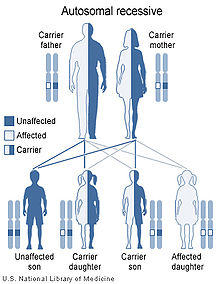- Nakajo syndrome
-
Nakajo syndrome Classification and external resources OMIM 256040 Nakajo syndrome, also called nodular erythema with digital changes,[1] is a rare autosomal recessive congenital disorder first reported in 1939 by A. Nakajo in the offspring of consanguineous (blood relative) parents.[2][3] The syndrome can be characterized by erythema (reddened skin), loss of body fat in the upper part of the body, and disproportionately large eyes, ears, nose, lips, and fingers.[1]
Genetics
 Nakajo syndrome has an autosomal recessive pattern of inheritance.
Nakajo syndrome has an autosomal recessive pattern of inheritance.
Nakajo syndrome is inherited in an autosomal recessive manner.[3] This means the defective gene responsible for the disorder is located on an autosome, and two copies of the defective gene (one inherited from each parent) are required in order to be born with the disorder. The parents of an individual with an autosomal recessive disorder both carry one copy of the defective gene, but usually do not experience any signs or symptoms of the disorder.
References
- ^ a b Online 'Mendelian Inheritance in Man' (OMIM) Nakajo syndrome -256040
- ^ Nakajo A (1939). "Secondary hypertrophic osteoperiostosis with pernio" (in Japanese). J Derm Venerol. 45: 77–86.
- ^ a b Kitano Y, M. E. (August 1985). "A syndrome with nodular erythema, elongated and thickened fingers, and emaciation". Archives of Dermatology 121 (8): 1053–1056. doi:10.1001/archderm.121.8.1053. PMID 4026345.
Categories:- Autosomal recessive disorders
- Congenital disorders
- Rare diseases
- Syndromes
- Genetic disorders with OMIM but no gene
- Genetic disorder stubs
Wikimedia Foundation. 2010.
